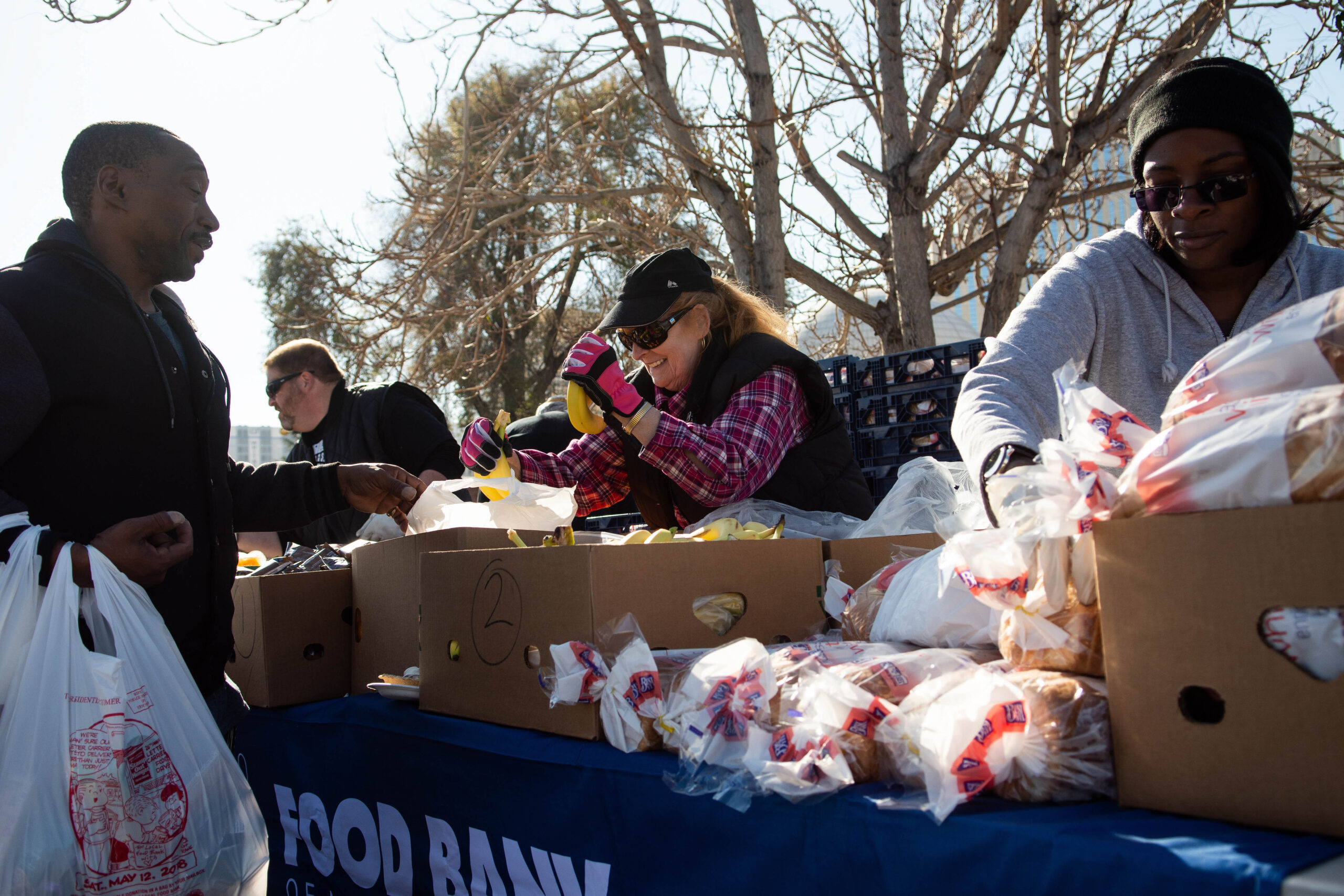1 in 6 Nevadans get food stamps. Many may lose benefits under Trump’s ‘big beautiful bill.'

The “One Big Beautiful Bill” signed by President Donald Trump earlier this month is likely to upend the food assistance program that serves 1 in 6 Nevadans, with expanded work requirements threatening thousands of recipients’ eligibility and the state expected to shoulder more of the program’s administrative costs.
The legislation cuts nationwide food stamp funding by about $186 billion through 2034, or a fifth of the total federal dollars allocated to the program. Its inclusion is an effort to offset some of the costs of extending tax cuts that will result in lower taxes across all income brackets, but primarily for the highest earners.
Food stamps, officially referred to as the Supplemental Nutrition Assistance Program (SNAP), provide cash assistance for low-income individuals to buy food at certain retailers. Although the full impact of the cuts have yet to be fully assessed by the state, early indications are that the bill will result in hundreds of thousands of Nevada families losing or seeing a reduction in their benefits.
Changes made in the bill will have far-ranging results: The eligibility of more than 130,000 Nevadans could be in doubt because of changes to work requirements, benefit amounts are less likely to increase over time, and the state will have to cover more administrative costs, which researchers say will result in less attention directed toward rooting out errors in the program. Additionally, there are about 10,500 refugees, asylees and non-citizen parolees in Nevada who are losing their SNAP eligibility, according to the state.
About 500,000 Nevadans participate in the program, according to the U.S. Department of Agriculture. The average Nevada household on SNAP received $166 in monthly benefits, amounting to about $6 daily and $2,000 annually, according to an analysis from the left-leaning Center on Budget and Policy Priorities.
The Urban Institute, an economic think tank, estimated that 265,000 families in Nevada could lose all or some of their benefits, with 85,000 families facing at least $25 in monthly benefit losses.
The bill has resulted in significant angst from officials focused on eliminating hunger in the Silver State — and it’s come at potentially the worst possible time. Inflation remains stubbornly high, the Trump administration has already cut certain food programs, food banks across the state have reported increasing demand in recent months and a surge in federal pandemic aid that expanded SNAP and other food programs is drying up.
All of it means more Nevadans are going hungry.
“There’s literally like 20 things that are contributing to what we’re facing right now,” said Lisa Segler, the chief operations and strategy officer for Three Square, Nevada’s largest food bank that distributed 41 million meals last year.
Still, much is still unknown about how the cuts might play out, prompting widespread uncertainty from officials working to combat hunger.
“We don't know what's really gonna come down, but whatever it is … we are intending on continuing our nimble spirit and leaning and working with our community partners to fulfill the deficits that we are facing,” said Brooke Neubauer, the CEO of The Just One Project, a Southern Nevada nonprofit focused on reducing food insecurity.
Republicans have said that the bill would reduce waste, fraud and abuse in food stamps by requiring states to bankroll more costs if they commit more payout mistakes, thereby incentivizing them to limit errors. If Nevada’s decreasing rate of errors continues, the state may be able to stave off a requirement to bankroll some of the costs.
Republicans also argue that the bill would further ensure that able-bodied people who can work are working to receive the benefits and restrict noncitizens from receiving food stamps (undocumented immigrants are already prohibited from receiving food stamps, but the bill would eliminate eligibility for refugees and asylees).
“Democrats will scream ‘cuts,’ but what they’re really defending is a wasteful program that discourages work, mismanages billions, and traps people in dependency,” House Speaker Mike Johnson (R-LA) said in a press release.
But critics disagree.
Yolanda Kemp, a state employee who helps determine Nevadans’ eligibility for SNAP, said in an interview that she often works with people who are unemployed or homeless. She recently interacted with a single mom now taking care of her niece and nephew — and that any cut in benefits could affect her ability to put food on the table.
“That’s extra mouths in her home to feed and she just does not have [the money],” said Kemp, who was speaking as a member of the American Federation for State, County and Municipal Employees Local 4041, rather than on behalf of the state. “The public perception is that someone is sitting at home in a basement or on their mom's couch, but that is not at all the case.”
Segler from Three Square added that “this is taking [recipients’] livelihood away.”
“The things I think about are kids having fewer meals, seniors literally having to skip dinner and ration more than they already do and then families that are working so many jobs and can barely make ends meet already,” she said.
Work requirements
Nevada currently has a waiver from the requirements that food stamp recipients who are “able-bodied adults without dependents” do paid work for at least 20 hours weekly. The waiver has been in place since early in the pandemic because of the state’s high unemployment rate, but it expires in January.
The new law significantly restricts the eligibility for these waivers to only include areas with an unemployment rate of at least 10 percent, which in Nevada would only apply to Mineral County, according to the latest unemployment data.
Kristle Muessle, a spokesperson for the state’s Division of Social Services which oversees SNAP, said in an email that the enrollment of about 133,000 SNAP recipients would be reevaluated when that waiver expires.
The bill also expands the work requirements to include adults aged 55-64 and people with dependents who are at least 14 years old. There are about 82,000 SNAP recipients in those categories who may now need to fulfill the work requirements, Muessle said.
“Who's the arbiter of a senior that is able and not able to work?” said Ian McDonough, a UNLV economist who researches food insecurity. “The assumption is that if you’re a senior not working, then you’re trying to defraud the system, which I don’t believe.”
A National Institutes of Health study from 2013 to 2017 found that work requirements for “able-bodied adults without dependents” resulted in one-third of those individuals losing SNAP benefits and a 3 percent decrease in total SNAP participation.
Gina Plata-Nino, the SNAP deputy director for the Food Research Action Center, a public policy group focused on reducing hunger nationwide, said in an interview that the new work requirements could particularly target single parents and other caregivers.
“Especially older women, they’re doing a lot of unpaid care for their grandkids, for their children,” Plata-Nino said.
Will Nevada have to foot some of the bill?
The federal government has always fully funded SNAP benefits, leaving implementation to the states. But under the new law, states could have to shoulder some of the food costs.
States with a payment error rate above 6 percent — meaning there was either underpayment or overpayment on at least 6 percent of benefit payouts — would be required to cover between 5 percent and 15 percent of total benefit costs starting in 2028. In fiscal year 2024, Nevadans received about $1 billion in benefits, so Nevada would need to pay between $50 million and $150 million if the error rate is too high.
However, Nevada’s error rate is moving in the right direction.
In fiscal year 2024, Nevada’s error rate was 5.94 percent, according to data published last month by the U.S. Department of Agriculture — an improvement from its 6.71 percent rate in the previous year.
Because the new cost model does not go into effect until 2028, it’s not clear whether Nevada might have to pay a portion of benefit costs until two years from now. The state’s error rate has fluctuated over time — for example, it was more than 7 percent in fiscal year 2022 but less than 6 percent five years earlier.
Still, no matter the error rates, Nevada and other states will have to foot more of the administrative costs.
Previously, the federal government reimbursed half of the dollars tied to food stamp administration, but beginning in fiscal year 2027, states will have to cover 75 percent of the costs.
In fiscal year 2025, the projected administrative cost to the state was about $83 million, which the state will pay half of, according to Muessle, the state spokesperson, but the state’s payment would have increased by about $20 million under the new model. Muessle said that the administrative cost for fiscal year 2026 is expected to be about $100 million.
Plata-Nino added that this will make it harder for the state to run the program effectively, which could result in higher error rates that will force Nevada to cover some of the benefit costs.
“Already, states don’t have enough resources to run the program properly,” she said. “They’re gonna lose the ability of the agencies to manage the program effectively, and not only result in service delays, staffing reductions, but less people being able to oversee the error rates.”
Fewer increases in SNAP benefits over time?
Under existing law, the federal government had to reevaluate the Thrifty Food Plan — an estimate of how much families are spending on groceries and the basis for calculating SNAP benefits — every five years.
In 2021, the reevaluation of the plan led to a more than 27 percent increase in benefits to Nevadans. The Urban Institute found that prompted a 3.6 percent reduction in poverty in the Silver State.
However, the bill removed this reevaluation requirement and requires that updates to the plan be cost-neutral. It means that the government cannot adjust the calculation for food stamps outside of changes from inflation, rather than a full review of the changing costs of a healthy diet.
“What this means is that they'll have less resources to be able to pay for child care or pay for rents or pay for their medicine because it's just not keeping up with the cost of food,” Plata-Nino said.
McDonough, the UNLV economist, added that the implications of the bill go beyond “whether people have empty stomachs.”
“It's really about potential rising health care costs stemming from these externalities, students struggling in school, lost productivity in the workplace, and then just putting sort of these community partnership programs, food banks under real financial strain,” he said.
